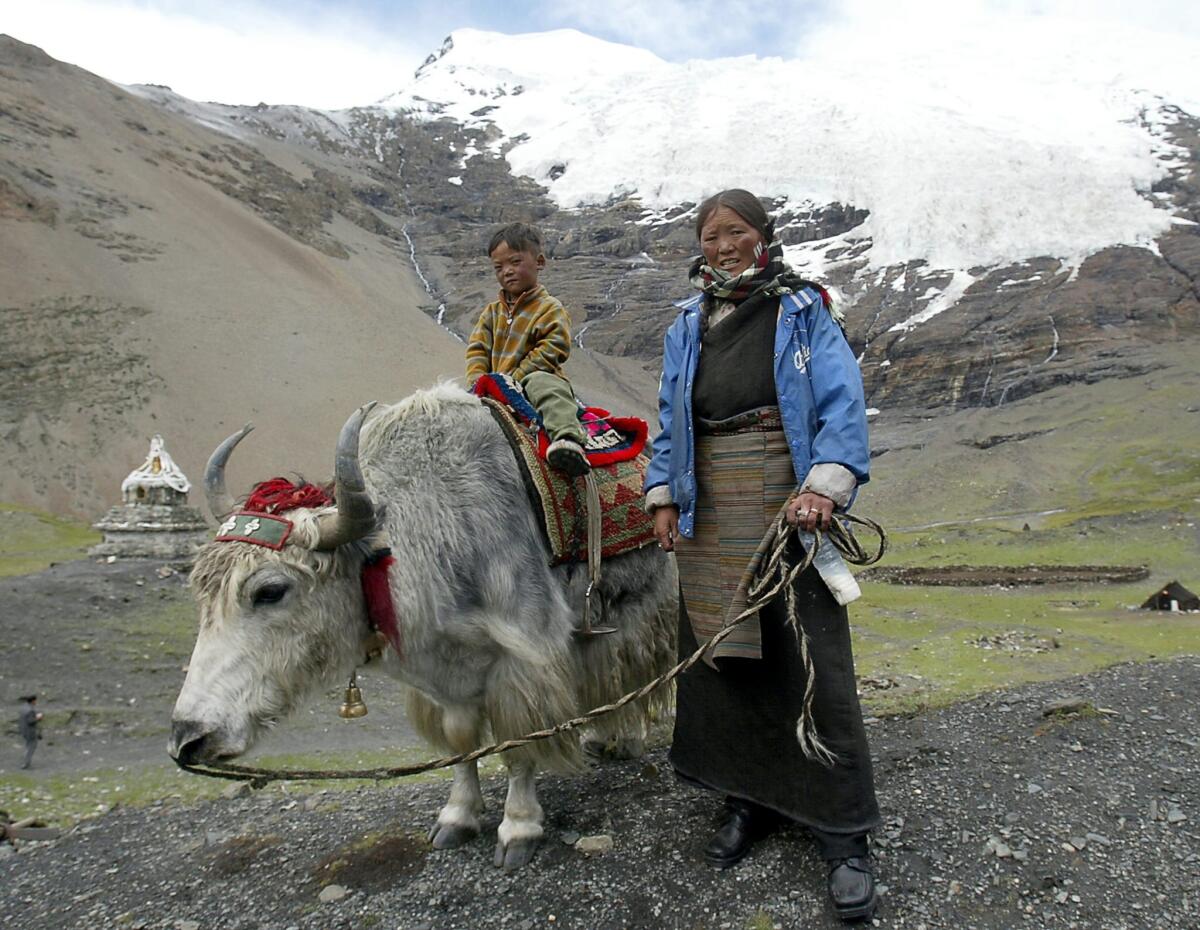Tibetans get high-altitude edge from extinct Denisovans’ genes

- Share via
Forget climbing Mt. Everest — for most humans, just eking out a living on the harsh Tibetan plateau is challenge enough. But Tibetan people have thrived there for thousands of years, and a new study says it’s thanks to a genetic adaptation they inherited from an ancient human relative.
The study, published Wednesday in the journal Nature, identifies a long segment of DNA shared by the extinct people known as Denisovans and modern-day Tibetans. The segment contains the gene scientists think gives Tibetans a lung up over lowlanders at high altitudes.
No one knew the Denisovans ever roamed the Earth until four years ago, when scientists sequenced the DNA of a finger bone unearthed in a cave in the Altai Mountains of southern Siberia. The genome exhibited similarities to that of modern humans and our extinct Neanderthal relatives, but it was different enough to be considered a distinct species.
Like Neanderthals, Denisovans mated with their human contemporaries, scientists soon discovered. People of Melanesian descent who today inhabit Papua New Guinea share 5% of their genetic makeup with the Denisovans.
Now it appears that Tibetans can also trace part of their ancestry to this mysterious group.
In the new study, scientists collected blood samples from 40 Tibetans and sequenced more than 30,000 nucleotides on a segment of DNA containing EPAS1, the gene that makes Tibetans so well-suited for life at high altitude. Then the scientists compared that sequence with those of 1,000 individuals representing the 26 human populations in the Human Genome Diversity Panel. They found the high-altitude gene in only 2 of the 40 Han Chinese people in the panel and no one else.
“Natural selection by itself could not explain that pattern,” said Rasmus Nielsen, a computational biologist at UC Berkeley and an author of the study. “The DNA sequence was too different from anything else we saw in other populations.”
So they investigated whether the gene might have been imported from extinct Neanderthals or Denisovans, and, bingo, they found a match.
But how did the gene end up in the genome of modern Tibetans? The scientists used computer models to test two different hypotheses. Were Denisovans and Tibetans descended from a common ancestor that gave the gene to both? Or did humans acquire the gene by mating with Denisovans?
Early humans and Denisovans probably diverged around half a million years ago, and it’s very unlikely that the gene could be maintained in both populations for so long, Nielsen said.
“By the process of recombination, DNA segments become shorter and shorter and shorter,” he said. “But here we have a very long segment that is shared. That’s very unlikely, statistically.”
Alternatively, the gene could have entered the Tibetan gene pool more recently via sex. Once transferred, the gene would have spread rapidly in the Tibetan population because of the merciless selective pressures of high-altitude living.
“Genetically, Han Chinese and Tibetans are very similar throughout the genome,” Nielsen said. “But for this particular gene, they are extremely differentiated from each other, which is something you only see with very strong or very recent selection.”
The reason Tibetans need EPAS1 is that their mountainous home — a crease of buckled crust thrust upward by the tectonic collision of India and Asia — lies about 15,000 feet above sea level, on average. Up there, the air contains 40% less oxygen than it does at low elevations.
Although previous studies had identified the importance of EPAS1, scientists still don’t know exactly what the gene does. They know only that it leads to lower levels of hemoglobin — the oxygen-toting protein in blood — in Tibetans who live at high altitude compared with people from low elevations who have acclimatized.
“That may sound counterintuitive,” said Nielsen — after all, wouldn’t you want more oxygen, and thus, more hemoglobin to deliver it? But people without the gene tend “overreact” at altitude.
“As we acclimatize, we’ll start to produce a lot of red blood cells,” he said, speaking for himself and other non-Tibetans. Too many, in fact. “That will expose us to various diseases like hypertension, increased risk of stroke and preeclampsia. There are very negative fitness effects of having too many red blood cells, and the Tibetans avoid them.”
So how do Tibetans get more oxygen? Presumably they don’t, Nielsen said, and scientists are still trying to understand the physiological mechanisms that allow them to cope.
But one thing is now clear: They owe their extraordinary fitness to a rogue gene introduced into the human genome from their long-lost cousins.
Abigail Bigham, an anthropologist at the University of Michigan who was not involved in the study, said now the search for Denisovan DNA should extend to other groups not represented in the Human Genome Diversity Panel.
“When they looked in Han Chinese, they saw it in only two individuals,” Bigham said. “But other populations in Central Asia or East Asia — there are 49 other ethnic minorities in China that have different genetic backgrounds — would have been interesting to look at as well.”
In any case, she said, the new study adds to a growing body of work that has reshaped the way scientists think about human evolution and our relationship to our extinct relatives.
For a long time, most scientists believed Neanderthals and Denisovans had nothing to do with modern humans. Now they realize that these species are responsible for introducing some of the genetic diversity that allowed people to adapt to unique environments.
“We’ve come full circle,” Bigham said. “Not only has there been interbreeding, but in fact that interbreeding has led to important functional changes in the human genome.”
For all things science, follow me @ScienceJulia







